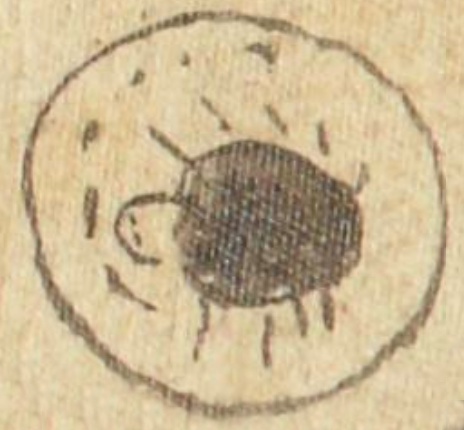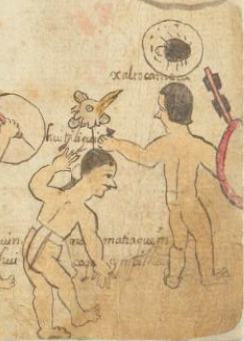Xaltocameca (Azca16)
This black-line drawing of the compound glyph for the ethnic name Xaltocameca (people of Xaltocan) shows a bird’s eye view of a circle with a few dots inside that seem to indicate sand (xalli). In this midst of this circle of sand is a spider (tocatl) with a large round black body, a head with two dots for eyes, and perhaps nine legs. One can easily see that the place name and the ethnic name are represented with the same type of glyph.
Stephanie Wood
The Xaltocameca play a large role on the pages of this manuscript that comprise Image 16. In this scene, they are taking captive the Mexica leader, Huitzilihuiitl, and his two daughters, Chimalxoch and Tozpanxoch.
Stephanie Wood
xaltocameca
Xaltocameca
Stephanie Wood
post-1550, possibly from the early seventeenth century.
Jeff Haskett-Wood
arena, arañas, etnicidades, pueblos, topónimos, nombres de lugares

xal(li), sand, https://nahuatl.wired-humanities.org/content/xalli
toca(tl), a spider, https://nahuatl.wired-humanities.org/content/tocatl
-can (locative suffix), where, https://nahuatl.wired-humanities.org/content/can-2
gente de Xaltocan
Stephanie Wood
The Codex Azcatitlan is also known as the Histoire mexicaine, [Manuscrit] Mexicain 59–64. It is housed in the Bibliothèque Nationale de France, and hosted on line by the World Digital Library and the Library of Congress, which is “unaware of any copyright or other restrictions in the World Digital Library Collection.”
https://www.loc.gov/resource/gdcwdl.wdl_15280/?sp=16&st=image
The Library of Congress is “unaware of any copyright or other restrictions in the World Digital Library Collection.” But please cite Bibliothèque Nationale de France and this Visual Lexicon of Aztec Hieroglyphs.




